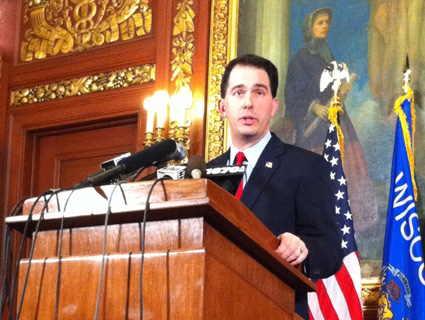
As many as 100,000 protesters massed outside the Wisconsin state Capitol on Saturday, Feb. 26, to protest Governor Scott Walker's "budget repair bill."John Murray/<a href="http://johnmurrayphoto.com/">johnmurrayphoto.com</a>
They piled off of buses and out of cars, filling the streets of Madison, Wisconsin, and surrounding the towering Capitol. Thousands crowded inside the building’s beautiful rotunda, their cheers echoing throughout the domed structure. An estimated 100,000 people had descended on frigid Madison to protest Republican Governor Scott Walker’s “budget repair bill,” a sweeping piece of legislation that would strip 170,000 public-sector workers of their right to collectively bargain.
Last Saturday’s “Rally to Save the American Dream” was the culmination of two weeks of protests and a 24-7 sit-in inside the Capitol. Not for 30 or 40 years have unions and progressive groups come together in such an outpouring of support for workers’ rights. What makes the Madison protests even more incredible is how spontaneous they have been: There has been no master plan, no long-anticipated strategy to turn Madison into ground zero for a reenergized labor movement.
What follows is a behind-the-scenes account of how the massive Wisconsin rallies came together, based on interviews with a dozen people who were intimately involved in them. It is by no means an exhaustive or complete account. But it offers a window into how the unions and their allies responded, swiftly and effectively, to what they saw as an existential threat.
Bracing For a Fight
Wisconsin Democrats sustained a historic beating on Election Day 2010, losing majorities in both chambers of the state legislature. Voters ousted the state senate majority leader and majority caucus leader, both Democrats. The Democratic assembly speaker didn’t even bother to run a reelection campaign, so confident was he that his working-class constituents would back him for another term. He lost, too.
But what really worried union members was the election of Republican Scott Walker, who won the state’s gubernatorial race by 5.7 points over Milwaukee mayor Tom Barrett. The unions feared that Walker, part of a new wave of conservative governors, would make Wisconsin a “right-to-work” state, joining 22 others where workers who don’t want to be part of a union can simply choose not to pay dues. Unions vehemently oppose right-to-work laws, saying they result in lower wages for all workers, endanger workers’ safety and health, and are unfair to workers who do pay union dues. “We had all these losses on November 2,” says Stephanie Bloomingdale, the secretary-treasurer of the AFL-CIO in Wisconsin. “On November 3, we began prepping for a right-to-work battle.”
In the weeks following the election, the Wisconsin AFL-CIO and other unions began plotting their anti-right-to-work campaign. “Don’t Let Politicians Take Your Union Away,” read the postcards Bloomingdale and her team mailed to every AFL-CIO member in the state. In early December, on the day that a group of state union honchos were set to talk strategy, the first bomb dropped: “GOP leader floats right-to-work law,” blared a headline in the Milwaukee Journal-Sentinel. The Republicans wouldn’t be in charge in Madison for another month, but the fight was already on.
“We All Expected the Worst—And It Was Worse”
Governor Walker took office on January 3. He wasn’t scheduled to unveil his “budget repair bill,” a set of cuts and stopgap measures aimed at plugging a $165-million hole in Wisconsin’s 2009-2011 budget, until the second week of February. But in the days before Walker’s announcement, bits of information trickled out about the governor’s plan, recalls Robert Kraig, the executive director of Citizen Action of Wisconsin. The rumors put Kraig on edge. “We’d heard they might go after the unions, maybe even try to repeal bargaining rights,” he says. “Still, we thought that was the long-shot option.”
At 6:45 p.m. on the Thursday before the budget announcement, the second bomb dropped. Someone in the Walker administration leaked a skeleton summary of the “repair” bill; Kraig got a copy from The Wheeler Report, a no-frills political website run by veteran Wisconsin reporter Dick Wheeler. He was stunned. Walker’s bill didn’t just attack unions: It was a move to wipe them off the map.
According to the leaked summary, the bill would eliminate collective bargaining for most public-sector unions, a move affecting 170,000 employees statewide. It would require public employees, who’d already taken a 3 percent pay cut in the previous two years, to contribute 5.8 percent of wages to fund their pensions and 12.6 percent of wages to pay for health care premiums. (Currently, they pay 0.2 percent of wages into their pensions and 5.6 percent of wages for health premiums. However, state employees fund 100 percent of their pensions through deferred compensation. Walker is demanding more money on top of that to fill a deficit in the pension fund.) Another provision would force unions to vote each year to maintain their union status—an unprecedented move by the governor.
Word of the bill’s contents spread like wildfire in the labor community, and Kraig was inundated with calls. On a voicemail to Kraig, Bruce Colburn, a top official with the Service Employees International Union (SEIU), exclaimed, “Robert, they’re going for everything!”
“We all expected the worst—and it was worse,” says Kraig.
By the time Walker officially unveiled his “repair” bill a day later, unions across the state had sprung into action. Some were setting up makeshift war rooms a block from the Capitol at the Concourse, the only unionized hotel in Madison. Volunteers piled into the offices of the Wisconsin Education Association Council, the state’s largest teachers union. Over the next two days, they called all 98,000 of WEAC’s members. That weekend, SEIU members hit the phones and Facebook to contact members and to pull together a rally on the following Tuesday.
Soon the hallways of the University of Wisconsin hospital were buzzing about the bill and the rally. Tim Swanson, an SEIU member and resident nurse in the hospital’s neuroscience intensive care unit, says coworkers started coming up to him and grilling him about Walker’s bill. At first, he says, organizing union members at the hospital was a challenge, “like dragging people out there to be active.” But as their anger mounted, people didn’t need any nudging. “Thank you, Scott Walker, for showing us what we need to do,” Swanson says with a half-laugh. “That we need to get off our duffs and fight for our futures and our children’s futures.”
The battle brewing in Madison didn’t really go national until the Associated Press published a short story in which Walker said he’d call in the state National Guard if public workers caused “unrest.” Kraig was in a meeting with union officials when an alert about the story landed in his email inbox. His eyes widened.
At that point Bloomingdale, the AFL-CIO secretary-treasurer, was driving back from Indiana where she’d spoken at a “Women of Steel” union event earlier that day. She heard about Walker’s National Guard threat about the same time Kraig did and right away wanted national coverage of the brewing controversy. “Blast it out,” she told him, referring to the national media list of 25 reporters Kraig had recently acquired from SEIU officials in Washington, DC. He hadn’t used the list that often, and he hesitated to use it now. But Bloomingdale wouldn’t relent.
“Just do it,” she said firmly. “Do it.”
School’s Out
For the union organizers, the weekend after Walker unveiled his bill was grueling, but it paid off. They were focused on turning out protesters to march outside the Capitol on Tuesday, when the state Senate finance committee would hold a hearing on Walker’s bill. The rallies drew 10,000 people, an impressive turnout given the short notice. Marching on a surprisingly warm day, protestors chanted “Union busting has got to go!”, while inside the rotunda, they booed loudly when Republican lawmakers offered support for the bill.
That evening, as the Wisconsin State Journal reported, 120 members of Madison Teachers Inc., the local teachers union, filed into the Madison Labor Temple. MTI’s leadership explained how the bill would hurt public school teachers, eating away at their pensions and health care benefits. According to MTI’s calculations, teachers would lose more than $5,100 a year each under Walker’s bill, and they could be fired without cause. By the end of the meeting, the decision was unanimous: For the next three days, those in attendance would go to the Capitol—not the classroom—to oppose the proposed cuts. The next day, more than a thousand teachers took to the streets, forcing the Madison School District to close its schools for the rest of the week.
The rallies only grew in size during the week after Walker’s announcement, as rank-and-file union members, teachers, and students were joined by people from all walks of life. Another 10,000 people marched at the Capitol on Wednesday, February 16, followed by 25,000 on Thursday and another 25,000 on Friday. On Saturday, nearly 70,000 pro-labor protesters clogged the streets surrounding the Capitol. There were Walker supporters in the crowd, too, but contrary to what Fox or CNN reported, they were vastly outnumbered.
But what heartened labor officials wasn’t just the turnout but the coalition of unions—public and private—they cobbled together on such short notice. They scored a major victory when the unions exempted from Walker’s proposed bargaining ban—the firefighters and police officers—decided to join the cause anyway. When the firefighters arrived on the streets of Madison that first week with their signs and fire helmets, one official with AFSCME compared it to the second Lord of the Rings, when the riders of Rohan come to the rescue of the good guys at the climactic Battle of Helm’s Deep.
The TAs Take Over
On Monday, February 14, more than 1,000 teaching assistants and their supporters arrived at Walker’s home in Milwaukee and at his office in the Capitol to deliver cards with a Valentine’s Day message: “We Heart UW: Governor Walker, Don’t Break My Heart.”
The demonstration, organized by the Teaching Assistants’ Association, UW-Madison’s union for teachers and graduate student project assistants, inadvertently sparked a weeks-long occupation of the Capitol. The state senate finance committee that was scheduled to hear public testimony on Walker’s bill the following day had set no limit on the speakers’ list. The TAA saw an opening.
The union quickly packed the speakers’ list with thousands of people. With a few state legislators present, the hearings went on deep into the night and didn’t stop, as speaker after speaker waited for their turn at the microphone. “Given that there was a large amount of people that wanted to speak, we decided to stay a night and it turned from waiting our turn to speak into an occupation,” Alex Hanna, TAA’s co-president, told The Atlantic.
The TAA later took over a third-floor office inside the Capitol and fashioned it into a command center. From there it blasted out emails, Facebook updates, tweets, and text messages; called supporters; and ordered food for those camped out in the Capitol. The union helped launch DefendWisconsin.org, an information and organizing hub that featured everything from talking points to press releases to videos. (So effective was the site that the Walker administration blocked access to the site on the Capitol’s open wireless network, according to attorneys for the Democratic Party of Wisconsin.)
Going Nuclear
“Fuck Scott Walker.” Tom Bird wrote those words on his Facebook page shortly after reading about the governor’s “repair” bill on Friday, February 11. His next thought was, Well, we probably can’t do anything about it. A skinny 22-year-old from Oshkosh, Bird is getting his master’s in nuclear engineering at UW-Madison. His specialty is plasma physics, not labor activism.
In the days after the bill came out, Bird started stopping by the protests. He joined a student walkout, trudging through the snow up to the Capitol with a friend. He says he didn’t fully join the cause until the state Senate’s 14 Democratic members fled the state on Friday, February 18, preventing a vote on Walker’s bill. (Nineteen state senators are Republicans; financial bills in the state senate require a quorum of twenty members.) After that, Bird started hanging out inside the Capitol, meeting people and marveling at the swelling crowd inside the rotunda. Before long, he was joining the raucous drum circle at the heart of the protest and manning the megaphone, always wearing his Wisconsin baseball cap.
On the ninth or tenth day of the protest, Bird and a group of diehards created the Capitol City Leadership Committee, an umbrella group of the half-dozen factions—the medics, TAA, protest marshals, and more—behind the occupation of the Capitol. The committee’s main job was to ensure that the protesters remained peaceful and respectful while still voicing forceful opposition to Walker’s bill.
The Wisconsin protests have radicalized Bird. One night, when I met him and some friends for drinks at an Irish pub in Madison, he pointed to his upper arm. “A few of us might get tattoos of the Wisconsin solidarity fist,” he told me. “Except on mine I want the Polish version: Solidarno??.”
A New Sense of Purpose
On Monday, February 21, Governor Walker gave his first press conference since the protests had erupted. By then, the controversy surrounding his bill was national news and the unions felt that they had the wind at their backs. Walker’s embarrassing 20-minute phone conversation with a prankster pretending to be right-wing billionaire David Koch only added to the unions’ momentum.
Two weeks later, the fight in Wisconsin rumbles on. Walker refuses to negotiate with the unions on the issue of collective bargaining, despite the unions’ willingness to make concessions on health care and pension contributions. The 14 Democratic state senators remain out of state, though it’s unclear how long they’ll stay away. On Tuesday, Walker released his budget plan for 2011-2013, a grab bag of proposals that drastically cuts aid to schools, local government, and women’s health programs.
Whether the unions’ round-the-clock organizing and protesting will stop Walker and the Wisconsin Republicans remains to be seen. A complete victory is all but impossible considering that they have already agreed to negotiate cuts to wages and benefits. But the past few weeks have been a test of organized labor’s ability to still flex its muscles in the face of powerful opposition, and that has left some supporters feeling a new sense of purpose. “Everyone has their turf,” says Diane Palmer, the state chapter president of the SEIU. “But this fight has united labor. We sit in one room, at one table, on one accord.”
















